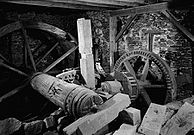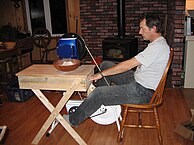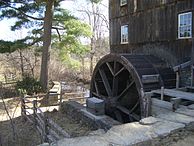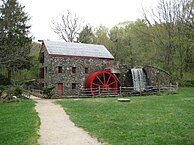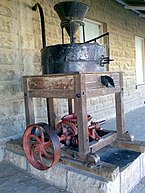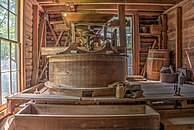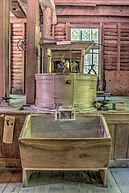Gristmill

Agristmill(also:grist mill,corn mill,flour mill,feed millorfeedmill) grindscerealgrainintoflourandmiddlings.The term can refer to either the grinding mechanism or the building that holds it.Gristis grain that has been separated from itschaffin preparation forgrinding.
History
[edit]Early history
[edit]
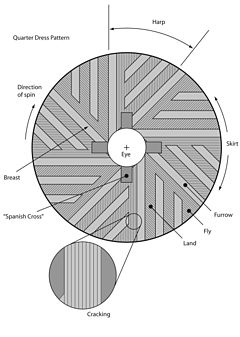
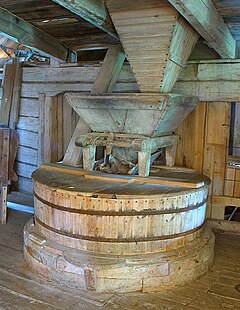

The Greek geographerStraboreports in hisGeographya water-powered grain-mill to have existed near the palace of kingMithradates VI EupatoratCabira,Asia Minor,before 71 BC.[1]
The early mills had horizontal paddle wheels, an arrangement which later became known as the "Norse wheel",as many were found in Scandinavia.[2]The paddle wheel was attached to a shaft which was, in turn, attached to the centre of themillstonecalled the "runner stone". The turning force produced by the water on the paddles was transferred directly to the runner stone, causing it to grind against a stationary "bed",a stone of a similar size and shape.[2]This simple arrangement required nogears,but had the disadvantage that the speed of rotation of the stone was dependent on the volume and flow of water available and was, therefore, only suitable for use in mountainous regions with fast-flowing streams.[2]This dependence on the volume and speed of flow of the water also meant that the speed of rotation of the stone was highly variable and the optimum grinding speed could not always be maintained.[2]
Vertical wheelswere in use in theRoman Empireby the end of the first century BC, and these were described byVitruvius.[3]The rotating mill is considered "one of the greatest discoveries of the human race". It was a very physically demanding job for workers, where the slave workers were considered little different from animals, the miseries of which were depicted in iconography andApuleius'The Golden Ass.[4][5][6]The peak of Roman technology is probably theBarbegal aqueduct and millwhere water with a 19-metre fall drove sixteenwater wheels,giving a grinding capacity estimated at 28 tons per day.[7]Water mills seem to have remained in use during the post-Roman period.
Manually operated mills utilizing a crank-and-connecting rod were used in theWestern Han dynasty.[8]
There was an expansion of grist-milling in theByzantine EmpireandSassanid Persiafrom the 3rd century AD onwards, and then the widespread expansion of large-scalefactorymilling installations across theIslamic worldfrom the 8th century onwards.[9]Geared gristmills were built in the medievalNear EastandNorth Africa,which were used for grinding grain and other seeds to producemeals.[10]Gristmills in the Islamic world were powered by both water and wind. The firstwind-poweredgristmills were built in the 9th and 10th centuries in what are now Afghanistan, Pakistan and Iran.[11]The Egyptian town ofBilbayshad a grain-processing factory that produced an estimated 300 tons of flour and grain per day.[12]
From the late 10th century onwards, there was an expansion of grist-milling in Northern Europe.[9]In England, theDomesday survey of 1086gives a precise count of England's water-powered flour mills: there were 5,624, or about one for every 300 inhabitants, and this was probably typical throughout western and southern Europe. From this time onward, water wheels began to be used for purposes other than grist milling. In England, the number of mills in operation followed population growth, and peaked at around 17,000 by 1300.[13]
Limited extant examples of gristmills can be found in Europe from theHigh Middle Ages.An extant well-preserved waterwheel and gristmill on theEbro Riverin Spain is associated with theReal Monasterio de Nuestra Senora de Rueda,built by theCistercian monksin 1202. The Cistercians were known for their use of this technology in Western Europe in the period 1100 to 1350.
Classical British and American mills
[edit]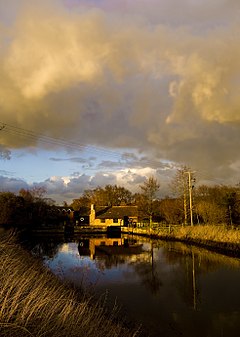
Although the terms "gristmill" or "corn mill" can refer to any mill that grinds grain, the terms were used historically for a local mill where farmers brought their own grain and received ground meal or flour, minus a percentage called the "miller's toll."[14]Early mills were almost always built and supported by farming communities and the miller received the "miller's toll" in lieu of wages. Most towns and villages had their own mill so that local farmers could easily transport their grain there to be milled. These communities were dependent on their local mill as bread was a staple part of the diet.
Classical mill designs are usuallywater-powered,though some are powered by the wind or by livestock. In a watermill asluicegate is opened to allow water to flow onto, or under, awater wheelto make it turn. In most watermills the water wheel was mounted vertically, i.e., edge-on, in the water, but in some cases horizontally (the tub wheel and so-calledNorse wheel). Later designs incorporated horizontal steel or cast ironturbinesand these were sometimes refitted into the old wheel mills.
In most wheel-driven mills, a large gear-wheel called thepit wheelis mounted on the same axle as the water wheel and this drives a smaller gear-wheel, thewallower,on a maindriveshaftrunning vertically from the bottom to the top of the building. This system of gearing ensures that the main shaft turns faster than the water wheel, which typically rotates at around 10rpm.
The millstones themselves turn at around 120rpm[dubious–discuss].They are laid one on top of the other. The bottom stone, called thebed,is fixed to the floor, while the top stone, therunner,is mounted on a separate spindle, driven by the main shaft. A wheel called thestone nutconnects the runner's spindle to the main shaft, and this can be moved out of the way to disconnect the stone and stop it turning, leaving the main shaft turning to drive other machinery. This might include driving a mechanicalsieveto refine the flour, or turning a wooden drum to wind up a chain used to hoist sacks of grain to the top of the mill house. The distance between the stones can be varied to produce the grade of flour required; moving the stones closer together produces finer flour.
The grain is lifted in sacks onto thesack floorat the top of the mill on thehoist.The sacks are then emptied into bins, where the grain falls down through a hopper to the millstones on thestone floorbelow. The flow of grain is regulated by shaking it in a gently sloping trough (theslipper) from which it falls into a hole in the center of the runner stone. The milled grain (flour) is collected as it emerges through the grooves in the runner stone from the outer rim of the stones and is fed down a chute to be collected insackson the ground ormealfloor. A similar process is used for grains such aswheatto make flour, and formaizeto makecorn meal.
In order to prevent vibrations from the millstones shaking the building apart, they were usually placed on a separate timber foundation, not attached to the mill walls, known as a husk. This foundation isolated the building from vibrations coming from the stones and main gearing and also allowed for the easy re-leveling of the foundation to keep the millstones perfectly horizontal. The lower bedstone was placed in an inset in the husk with the upper runner stone above the level of the husk.
The automatic mill
[edit]
American inventorOliver Evansrevolutionized the labor-intensive process of early mills at the end of the eighteenth century when he automated the process of making flour. His inventions included the Elevator, wood or tin buckets on a vertical endless leather belt, used to move grain and flour vertically upward; the Conveyor, a wooden auger to move material horizontally; the Hopper Boy, a device for stirring and cooling the newly ground flour; the Drill, a horizontal elevator with flaps instead of buckets (similar to the use of a conveyor but easier to build); and the Descender, an endless strap (leather or flannel) in a trough that is angled downward, the strap helps to move the ground flour in the trough. Most importantly, he integrated these into a single continuous process, the overall design later becoming known as the Automatic (or Automated) mill. In 1790 he received the third Federal patent for his process. In 1795 he published "The Young Mill-Wright and Miller’s Guide" which fully described the process.[15]
Evans himself did not use the term gristmill to describe his automatic flour mill, which was purpose designed as a merchant mill (he used the more general term "water-mill" ). In his book his only reference to "grist" (or "grists" ) is to the small batches of grain a farmer would bring in to have ground for himself (what would be generally called barter or custom milling). In his book, Evans describes a system that allows the sequential milling of these grists, noting that "a mill, thus constructed, might grind grists in the day time, and do merchant-work at night."[16]Over time, any small, older style flour mill became generally known as a gristmill (as a distinction from large factory flour mills).
Modern mills
[edit]

Modern mills typically use electricity orfossil fuelsto spin heavy steel, or cast iron, serrated and flat rollers to separate thebran and germfrom theendosperm.The endosperm is ground to create white flour, which may be recombined with the bran and germ to create whole grain orgraham flour.The different milling techniques produce visibly different results, but can be made to produce nutritionally and functionally equivalent output. Stone-ground flour is preferred by many bakers and natural food advocates because of its texture, nutty flavour, and the belief that it is nutritionally superior and has a better baking quality than steel-roller-milled flour.[17]It is claimed that, as the stones grind relatively slowly, the wheat germ is not exposed to the sort of excessive temperatures that could cause the fat from the germ portion tooxidizeand become rancid, which would destroy some of the vitamin content.[17]Stone-milled flour has been found to be relatively high in thiamin, compared to roller-milled flour, especially when milled from hard wheat.[17]
Gristmills only grind "clean" grains from which stalks andchaffhave previously been removed, but historically some mills also housed equipment forthreshing,sorting, and cleaning prior to grinding.
Modern mills are usually "merchant mills" that are either privately owned and accept money or trade for milling grains or are owned by corporations that buy unmilled grain and then own the flour produced.
Pests
[edit]One common pest found in flour mills is theMediterranean flour moth.Moth larvae produce a web-like material that clogs machinery, sometimes causing grain mills to shut down.[18]
Gallery
[edit]-
Gristmill with water wheel, Skyline Drive, Virginia, 1938
-
Gristmill hopper,Skyline Drive,Virginia, 1938. Grain was funneled through the hopper to a grinding stone below.
-
Gristmill drive machinery,Thomas Mill,Chester County,Pennsylvania
-
Pedal powered wheat mill,Shediac Cape, New Brunswick
-
Remnants of some of the scores of flour mills built inMinneapolisbetween 1850 and 1900. Note the undergroundMill racethat powered mills on the west side of theMississippi RiveratSt. Anthony Falls.
-
Wheel of the 1840s-era Grist Mill atOld Sturbridge Villagein Sturbridge, Massachusetts
-
"Slipper" feeding corn into the grindstones ofGeorge Washington's Gristmill
-
Old turbine wheel at the old grist mill inThorp, Washington
-
The grist mill at theWayside InninSudbury, Massachusetts
-
Grist mill atJarrell Plantation,acquired 1899
-
Water-powered corn mill at Mingus Mill[19]
See also
[edit]References
[edit]- ^Wikander 1985,p. 160;Wikander 2000,p. 396
- ^abcdDenny, Mark (4 May 2007). "Waterwheels and Windmills".Ingenium: five machines that changed the world.Johns Hopkins University Press.pp.36–38.ISBN978-0-8018-8586-0.Retrieved15 December2009.
norse wheel.
- ^Oleson, John Peter(30 Jun 1984).Greek and Roman mechanical water-lifting devices: the history of a technology.Springer. p. 373.ISBN90-277-1693-5.ASIN9027716935.
- ^Bradley, Keith R.Apuleius and Antonine Rome: Historical Essays.p. 68.
- ^Welborn, L.L.Paul, the Fool of Christ.Bloomsbury. p. 75.
- ^Erskine, Andrew (26 December 2012).A Companion to Ancient History.Wiley. p. 493.ISBN9781118451366.
- ^Hill, Donald(2013).A History of Engineering in Classical and Medieval Times.Routledge.pp. 163–164.ISBN9781317761570.
- ^Hong-Sen Yan, Marco Ceccarelli (2009).International Symposium on History of Machines and Mechanisms.Springer Science and Business Media. p. 236.ISBN978-1-4020-9484-2.
- ^abHill, Donald(2013).A History of Engineering in Classical and Medieval Times.Routledge.p. 163.ISBN9781317761570.
- ^Hill, Donald Routledge(1996). "Engineering". In Rashed, Roshdi; Morelon, Régis (eds.).Encyclopedia of the History of Arabic Science.Routledge. pp. 751–795.ISBN978-0-415-12410-2.: 781
- ^Adam Lucas (2006),Wind, Water, Work: Ancient and Medieval Milling Technology,p. 65,Brill Publishers,ISBN90-04-14649-0
- ^Hill, Donald(2013).A History of Engineering in Classical and Medieval Times.Routledge.p. 164.ISBN9781317761570.
- ^Gimpel, J.,The Medieval Machine,Gollanz, 1976, Chapter 1.
- ^"ARTFL Project: Webster Dictionary, 1913".The University of Chicago - Department of Romance Languages and Literature. Archived fromthe originalon 2007-03-13.Retrieved2006-09-28.
- ^"Old Stone Mill - History of the Old Stone Mill".
- ^Evans, Oliver,The Young Mill-Wright and Miller’s Guide,Oliver Evans, Philadelphia, 1795, Chapter II, pp.88-90
- ^abcCampbell, Judy; Mechtild Hauser; Stuart Hill (1991)."NUTRITIONAL CHARACTERISTICS of ORGANIC, FRESHLY STONE-GROUND, SOURDOUGH & - CONVENTIONAL BREADS".Ecological Agriculture Projects Publications.Ecological Agriculture Projects. Archived fromthe originalon 18 February 2003.Retrieved15 December2009.
- ^"Mediterranean Flour Moth (Department of Entomology)".Department of Entomology (Penn State University).Retrieved2017-11-14.
- ^"Mingus Mill in the Smokies - Grist Mill Near Cherokee NC".
- Wikander, Örjan(1985). "Archaeological Evidence for Early Water-Mills. An Interim Report".History of Technology.Vol. 10. pp. 151–79.
- Wikander, Örjan (2000). "The Water-Mill". In Wikander, Örjan (ed.).Handbook of Ancient Water Technology.Technology and Change in History. Vol. 2. Leiden: Brill. pp. 371–400.ISBN90-04-11123-9.
Further reading
[edit]- Richard Bennett & John Elton.History of corn milling(London, Simpkin, Marshall and company, 1898).
- Volume 1 - Handstone, Slave and Cattle Mills
- Volume 2 - Water and Wind Mills
- Volume 3 - Feudal Laws and customs of Mills
- Volume 4 - Some famous feudal mills
- History of Cannon River Mills in Southern MN, USA



